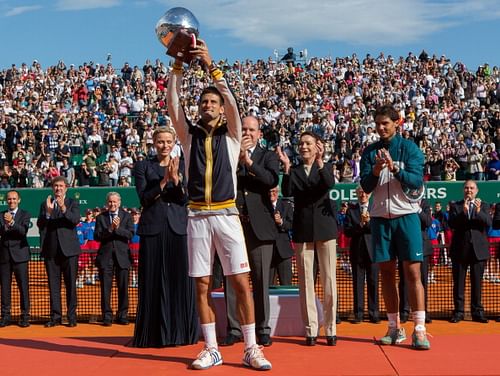
Why Nadal shouldn't get a seeding bump for Roland Garros

Rafael Nadal holds the trophy after beating compatriot Nicolas Almagro in the final of the recently concluded Barcelona Open Banc Sabadell on April 28, 2013. (Getty Images)
We’re less than a month away from the start of the French Open… or should we say the start of Roland Garros… and one of the major discussion points has been the seeding of Rafael Nadal, the Spaniard who has dominated this tournament like none before him. Many would like to see Nadal’s seeding bumped up from his current world ranking of no. 5 to no. 4 or even higher.
Nadal has reached the finals of all six tournaments in his comeback since February, winning four titles – three of those coming on clay. His current ranking is more a reflection of his eight month injury lay-off post Wimbledon last year. Once he starts racking up wins on the grass courts in London and the hard courts in North America in the second half of the season, he could be chasing for the no. 1 ranking again.
But for now, and in all probability until the French Open, Nadal is ranked no. 5, behind world no. 1 Novak Djokovic, no. 2 Roger Federer, no. 3 Andy Murray and no. 4 David Ferrer. With a ranking and thereby a seeding of no. 5, Nadal could face top ranked Djokovic as early as the quarter-finals. Djokovic is the biggest threat to Nadal’s hopes of winning an eighth French Open title in nine years and the Serb reinforced that with his win over Nadal in the Monte Carlo finals a couple of weeks ago.
Guy Forget, the former French Davis Cup captain and Roland Garros committee member, supports the idea that Nadal should get a seeding bump. “Since we can see them (Nadal and Djokovic) meeting in the finals of the biggest events in the next weeks, it would be a shame to have them [meet] in a quarter-final in Roland Garros. The rules state the Grand Slam events have the right to change the seeding regarding the situation of the players. Wimbledon has done that in the past. I would not find it illogical to change the seeds.”
The legendary John McEnroe went one step further and said that Nadal should be seeded no. 1. “Let me put it to you this way: I guarantee you that none of those four guys, as great as they are, want to see him in the quarters. Quite honestly, I would seed him number one… [I] think he deserves that. I think the other players deserve it.”
While Forget and many others may support the idea that Nadal should get a top 4 seeding, I, for one, think that the seeding should be based on the world rankings, as it has always been. Simply because, there is no precedent for the same. All the grand slams, barring Wimbledon, have stuck to the world rankings to determine their seedings. Even Wimbledon, which used to be determine its seedings by the vote of a seeding committee, now uses a pre-determined points formula to devise its seedings. And making an exception this time not only undermines the efforts of other players but could open up the door to making such exceptions in the future – to suit the demands of sponsors, players and television executives.
One of the major factors that have determined champions in the past has been the luck of the draw. Would Roger Federer have won the French Open if the draw did put Robin Soderling on the opposite side of the net against Nadal in 2009? Serena Williams, Maria Sharapova, Kim Clijsters and Justine Henin have all had lengthy injury lay-offs during their careers. How different would the history of women’s tennis be if they had received seeding bumps on their comeback?
Also, those who are asking for a Nadal seeding bump are forgetting the effect it has on the current world no. 4 Ferrer. If Ferrer does manage to hold on to the no. 4 ranking in the next few weeks, he’s rightfully earned it by grinding out victories over the past 12 months. With a seeding of no. 4, there’s a 25% chance of him meeting Nadal and a 75% chance of him drawing Jo-Wilfried Tsonga, Tomas Berdych or Juan Martin del Potro in the quarter-finals. With a seeding of no. 5, Ferrer will have to contend with a possible quarter-final against either Djokovic, Murray, Federer or Nadal. It’s a no-brainer which draw Ferrer, or any other player, would prefer.

Novak Djokovic (front) recently beat Nadal at the Monte-Carlo Masters in straight sets and could possibly meet him the quarter-finals of the French Open. (Getty Images)
One must also consider the wider implications of making an exception this time for Nadal. The Spaniard has a ready alibi in the form of his injured knees for the rest of his career. If he does get the special treatment this time and goes on to win Paris once again, what’s to stop him from skipping the hard court season (which he has long been criticizing for the pounding inflicted on a player’s body) and re-emerging next season in time for the clay court season – knowing that his ranking going down will not affect his seeding at Roland Garros. And what is to stop the US and Australian Opens from making similar exceptions for Nadal or another top player the next time they are out for an extended period. That would make a mockery of the rankings, especially for players who work hard all year round to earn the ranking points.
As they say, you have to beat the best players in a tournament to win an event, whether it’s in the first round or the last. Tampering with tradition to ensure Nadal and Djokovic do not meet until the semis or the finals in Paris would be blasphemous for the tennis traditionalists.